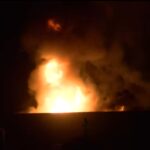Kīlauea, located on Hawaiʻi’s Big Island, is one of the most active volcanoes in the world, known for its spectacular eruptions and significant cultural importance. Its name, which translates to “spewing” or “much spreading” in Hawaiian, aptly describes its frequent and dramatic lava flows that captivate both scientists and visitors alike. The volcano’s shield-like profile, formed by fluid lava flows, has shaped the Hawaiian landscape for centuries, making it a defining feature of the island.

On January 15, 2025, Kīlauea once again demonstrated its volcanic might by resuming eruptive activity within its summit caldera. This marked the fourth eruption in the series that began on December 23, 2024, thrilling visitors with its fiery display. Lava fountains shot up to 200 feet, lighting up the night sky and drawing crowds to Hawaiʻi Volcanoes National Park. The eruption not only provided a breathtaking natural spectacle but also served as a reminder of the geological forces that continue to shape the Hawaiian Islands.
Kīlauea’s summit is home to the Halemaʻumaʻu crater, considered sacred by native Hawaiians as the legendary dwelling place of Pele, the goddess of fire and volcanoes. Over the years, the crater has undergone significant changes, particularly during the 2018 eruptions, when massive summit collapses expanded the crater and altered its landscape. These dramatic changes have highlighted the dynamic and ever-evolving nature of Kīlauea’s volcanic system.

The eruptions at Kīlauea are closely monitored by the U.S. Geological Survey’s Hawaiian Volcano Observatory, which provides real-time updates and safety advisories. The observatory’s meticulous monitoring helps to ensure the safety of residents and visitors, as volcanic eruptions can pose hazards such as lava flows, toxic gases, and ashfall. Authorities urge all visitors to follow safety guidelines, stay on designated trails, and remain vigilant while observing the volcano’s activity.
Hawaiʻi Volcanoes National Park is one of the best places to witness Kīlauea’s fiery displays, offering multiple vantage points for safe observation. Visitors are advised to check with park officials for the latest updates on viewing conditions and to respect the park’s safety protocols. The opportunity to witness Kīlauea in action is a rare and unforgettable experience, drawing visitors from around the world.
Beyond its visual grandeur, Kīlauea holds profound cultural and scientific significance. It is a living laboratory for volcanologists studying the processes of magma movement, eruption dynamics, and the creation of new land. For native Hawaiians, it is a sacred site, deeply tied to their mythology and traditions. The ongoing eruptions serve as a reminder of the powerful connection between the natural world and cultural heritage.
The recent activity at Kīlauea reaffirms its status as a geological marvel and a symbol of Hawaii’s ever-changing landscape. As the lava flows and fountains illuminate the night, they inspire awe and respect for the incredible forces that shape our planet. For those fortunate enough to witness it, Kīlauea offers an unparalleled glimpse into the fiery heart of the Earth.






